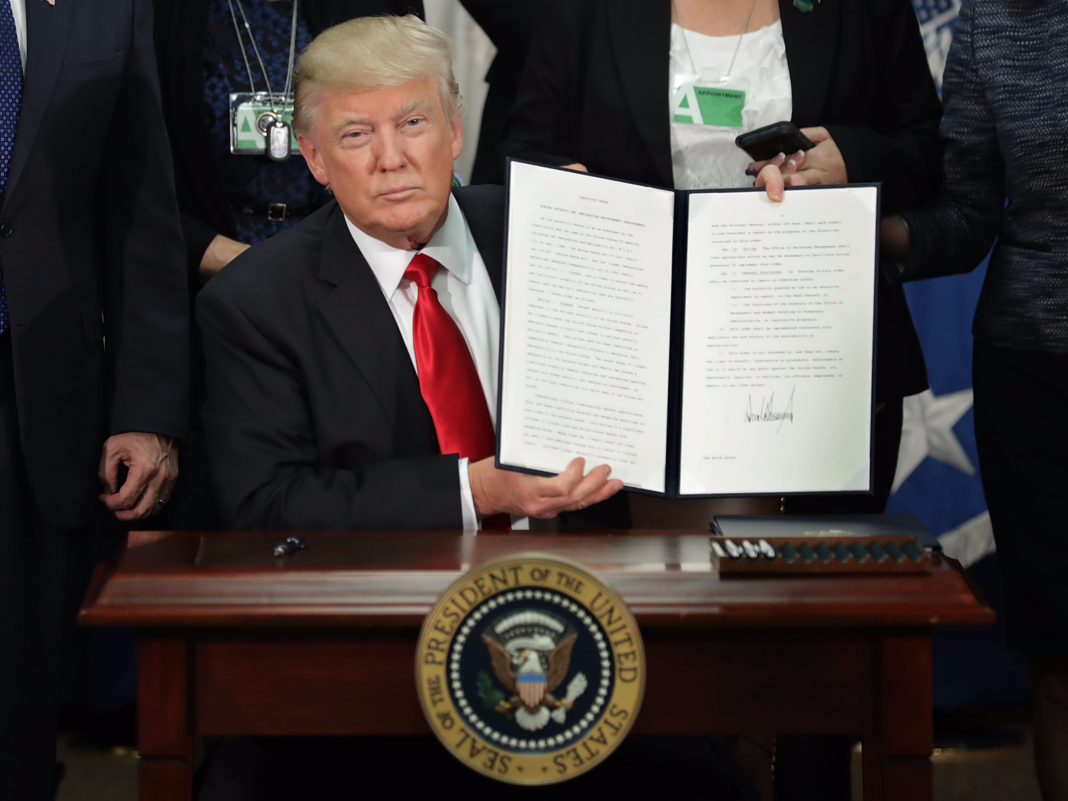The new immigration executive order is better than the old one. Here are the main things it gets right, and the big questions it leaves unanswered.
The administration’s immigration policy is in the news again, this time with a revised immigration and refugee executive order, and mainstream media outlets are making sure everybody knows that the new order is pure evil.
However, as with the last iteration of this executive order, very little of the commentary seems based on its actual facts, which you can read here. Is it just the same old ban recycled? Did the administration completely walk back its entire policy? What actually happened?
In this article, I’ll walk you through the new order piece by piece, explaining how it’s different from the last one. But before we get to the order’s text, we should take a second to consider how telling it is that a whole new order was released. Revoking the old order and issuing a new one, instead of fighting out the lawsuits for the old order, suggests that the administration expected to lose at least some of those lawsuits. It also suggests they listened to critics (like me) who suggested that revoke, revise, and replace was better than trying to stick to the old order.
This new executive order makes some important fixes that improve the administration’s refugee and immigration policy in notable ways. However, in at least one respect, it continues to betray the priorities of conservatives, perhaps even more than the initial order.
Administration Is Defensive About Country Selection
Evidently, my line of criticism suggesting that there was no rational tie between the countries selected struck a nerve somewhere in the administration. In this new order, they have provided 10 paragraphs of details about why they chose those seven initial countries.
However, I think the administration does protest too much. The new list of countries is cut to just six, and no longer specifically restricts Iraq. It does still specifically restrict Iran, Sudan, Syria, Yemen, Somalia, and Libya. Three reasons are given: “Each of these countries is a state sponsor of terrorism, has been significantly compromised by terrorist organizations, or contains active conflict zones.”
Syria, Iran, and Sudan fall under the “state sponsors of terror” heading, according to the state department. So a ban on those three as a group certainly has some rational ties if the administration believes state sponsors are likely to export terror, which seems perfectly reasonable to believe.
Next, comes the “armed conflict” rationale. According to Wikipedia, four countries have ongoing armed conflicts with at least 10,000 fatalities in 2016: Afghanistan, Iraq, Syria, and Mexico (the drug war). Of those, only Syria remains specially restricted. I’ll discuss Iraq more below.
Meanwhile, another 10 armed conflicts have had at least 1,000 casualties in 2016: Turkey, Syria, Iraq, Somalia, Kenya, Nigeria, Sudan, Cameroon, Niger, Chad, Libya, Yemen, Saudi Arabia, Egypt, South Sudan, and Ethiopia. Again, of those, just Syria, Somalia, Sudan, Libya, and Yemen are targeted. So on the armed conflict front, we do get several of the banned countries… but lots of other countries too, many with far more severe conflicts.
Finally, we come to countries “significantly compromised by terrorist organizations.” No detail is given about what this means, and no country is specifically identified in the new order under that designation. However, the document the order cites does include a section about terrorist safe-havens. The State Department identifies Mali as being a terrorist safe haven, as well as the Philippines, Egypt, Iraq, Lebanon, Libya, Yemen, Afghanistan, Pakistan, Colombia, and Venezuela. Again, several of these countries are on the list of restricted countries, but much more are not.
Thus, the exhaustive explanation given ultimately explains nothing. The executive order could be read to imply that banned countries meet these criteria and provide poor documentation on citizens: but that’s not the case for Iran, which is on the list, while poor-documenters like Mali, South Sudan, Chad, or Niger are not on the list.
In other words, while quite verbose, the reasoning provided does not explain why the six countries still under special restrictive status remain so. There may indeed be a good reason for caution from these countries, but, if so, then undoubtedly the same holds for numerous other countries as well. If the administration has selected these six for mere expediency, triaging the most dangerous countries, then they should clarify their reasoning on why these countries are the most dangerous, when they are not demonstrably different from many other countries in terms of terrorism and active conflict.
The list is shorter now, which I’ll show below represents an improvement. But ultimately, on the “why were these countries chosen” front, the new order gives no additional clarity.
Iraqis Allowed Back In 1(g) and 1(h)
Of course, one major change did occur: Iraq was dropped from the list. Here, the administration can count a success amid the general failure of the initial order. According to the new order, Iraq has made credible pledges to improve their domestic screening and to support stricter vetting. This is ultimately the end goal of the administration for every country on this list, so in Iraq we can see an example of what the administration hopes will happen everywhere: we’ll play rough with another country for a few weeks or months, then they’ll blink first and agree to support the implementation of stricter screening for visas, and help provide resources to do it. The mainstream media isn’t going to report the case of Iraq as a success. But if the new EO’s claims about Iraqi compliance are true, then it indicates at least a small part of the original EO’s political strategy.
However, there is a concerning statement in this same section. Namely, “The Attorney General has reported to me that more than 300 persons who entered the United States as refugees are currently the subjects of counterterrorism investigations by the Federal Bureau of Investigation.” This is quite jarring. Not because refugees are perfect; they aren’t. Some refugees have indeed become terrorists, though the number is fairly small.
Rather, what’s jarring here is the presumption of guilt: if the FBI is doing its job correctly, then, of course, the number of investigations will be large. And the vast majority should be innocent. We don’t want the FBI only opening investigations after they’re sure of guilt! Claiming that this “300 investigations” number is meaningful would be deeply misguided, especially since over 1 million people admitted as refugees reside in the United States today.
It seems obvious, of course, why the number of investigations was cited rather than the number of convictions: the number of convictions is an unimpressively small number over the last decade (somewhere between 10 and 60 convictions; exact data is hard to come by).
Visa Control Better Managed This Time: 2(a) through 3(c)
The visa ban last time came suddenly, with no rules for exceptions, and its application was haphazard. First dual citizens were banned, then allowed. Permanent residents were banned, then allowed. The rules kept changing and hadn’t been properly thought out, and people with legally valid visas were denied entry. The new order is vastly better organized.
The new order delays implementation until later this month, allowing time for travel plans to be made by visa-holders, and for government agencies to make implementation plans. It also provides categorical exceptions, in addition to case-by-case powers granted to DHS. This is vital and was one of my core criticisms of the initial order. The lack of categorical exceptions made the policy far too draconian and, ultimately, unenforceable. Now, categorical exceptions are made for refugees, diplomats, dual nationals, permanent residents, and existing visa-holders. It also allows back in anybody booted out under the old order, and explicitly acknowledges the right to asylum claims. It also provides illustrative examples of why case-by-case waivers might be granted: for students, for legitimate business activities, if a person resides with a U.S. citizen family member, for an infant or adopted child, or U.S. government employees, etc.
These changes are crucial. Essentially, instead of a total travel ban, the administration is saying they will only issue new visas to the six restricted countries under exceptional conditions. That is a monumental change in emphasis and is well within the powers of the President. Basically, instead of the “default setting” for Iran being “we’ll issue a travel visa if we don’t find anything bad,” now it’s “we’ll only issue a travel visa if you have a specific reason to travel.” You can disagree with this policy or agree with it, but it’s light-years more reasonable, enforceable, and in keeping with American values than the former policy—and it’s far more reasonable than most media outlets are probably going to admit.
Priorities of Religious People Abandoned: 6(a) to 6(d)
However, while improvements were made to many sections related to visas and immigration, the new order’s section on refugees remains deeply saddening. The old executive order prioritized religious minorities while also banning all Syrian refugees forever, and banning all refugees from all countries for 120 days. The new order does not prioritize religious minorities, doesn’t ban Syrian refugees at all, but does still pause refugee admissions for 120 days.
First, let’s talk about improvements. The new order creates explicit permission for refugees already in transit or scheduled for admission to enter the country. That’s good because otherwise you just get refugees who we’ve already promised to care for trapped in airports as we suddenly renege on our promise. If we’re a nation that keeps its promises, we can’t behave like that. So this administrative change is a real improvement.
Likewise, removing the blanket ban on Syrian refugees is a good thing even, if you support extreme vetting of Syrians. Some Syrians are deserving refugees who we want to allow in! Maybe not all, and certainly we want to be cautious, but nobody thinks “zero” is the right number of deserving Syrian refugees. With appropriately strict vetting, surely at least a few Syrians are legitimate refugees we want to accept.
Next, we can look at a change that probably doesn’t matter on its own: the religious preference is gone. The reality is that current U.S. law already prioritizes persecuted religions and religious minorities, as I’ve shown extensively elsewhere. Adding the religious preference in the old order really didn’t change U.S. law at all, so dropping it in the new order would also have the same outcome. It just doesn’t matter either way.
That is, on its own, the religious preference didn’t matter. Combined with the rest of the order it may matter. In the old executive order, the religious preference appeared to be a special way that persecuted minorities could be let into the country despite the 120-day pause, maybe despite the 50,000 refugee camp. The case-by-case religious waiver was written fairly broadly, so its exact extent wasn’t clear, but it basically served as a tool to make the whole cap-and-pause system a bit more in keeping with American, and Christian, values.
But now? Now we’ve paused admissions for 120 days from March 16 (so until mid-June) with an option for further extension. We’ve still capped at 50,000 refugees total, and we’ve removed the one hint of a tool we had to aid our suffering brethren around the world. We have simply closed our doors to religious minorities, especially Christians, fleeing persecution. To reach just 50,000 admissions in this fiscal year, we will have to have one of the slowest paces of refugee admissions for the remaining months that we’ve ever had.
As I said in my discussion of the old executive order: reducing refugee admissions from Obama-era highs of around 110,000 may be reasonable. But cutting them to historically ungenerous levels adds nothing to American safety while tarnishing our image.
What’s the Same In This New EO?
The rest of the order is essentially unchanged. The visa interview waiver program is suspended, creating a hassle for repeat foreign travelers. Biometric exit tracking is expedited, which may improve security, but will create an extra hassle for Americans leaving the country too. Countries with visa reciprocity are pressured to ensure they honor their agreements. None of these provisions are very controversial, and none changed substantively.
Some media outlets have raised concern about a section 5(g), which says “to the extent permitted by law and as practicable, State and local jurisdictions be granted a role…” in managing the refugee program. But concerns on that front seem misplaced, as this section is essentially unchanged from the original order, it explicitly recognizes the goal is to be achieved within existing law, and refugee programs as they exist today already include the buy-in of numerous state and local institutions.
The New EO Is Better But Still Needs Fixing
The new executive order is better than the old one. First of all, it shows actual thought and competence. Important waivers, exceptions, delays and administrative measures are included to ensure it runs smoothly and doesn’t break the law. The most draconian measures were removed, focusing attention on more clearly legal, achievable goals. Some initial objectives have already been achieved, like getting Iraq on board with tougher vetting. The blanket ban on Syrian immigrants was removed. These are all good changes that show the administration is listening to critics and incorporating feedback, a welcome trend that all Americans should want from their government.
However, key problems remain. We still have no real clarity, despite an exhausting wall-of-words, about why those specific countries were targeted. We still have a pause in refugee admissions without any good reason for it. We still have no clarity on how vetting procedures are going to be improved. We still have an incredibly low refugee admission cap out of line with traditional American values.
The administration has made real progress improving one of their flagship policy initiatives. They should keep making progress by raising the refugee cap to a more reasonable figure (maybe 70,000 or 80,000—still 30,000 below President Obama), explaining more clearly why they chose the countries they did and not other countries, and by continuing active refugee processing efforts even while they improve vetting. These changes won’t meaningfully endanger Americans. They will make programmatic goals easier to implement, will shield the administration from some ongoing criticism, and will show their continued commitment to aggressively promoting America’s traditional role as leader of the free world: first in war and, as the millions of refugees we have housed will acknowledge, first in peace.





